Hellenic Foundation for Culture maintained an active publication program since its inception in 1992. The publications have mainly been produced in support of the events and exhibitions of the Foundation, but also include scholarly works.
Since 2011, the publication program has been suspended due to the economic pressures on the Greek state. We hope to restart our publication program in the near future, but in the meantime a number of our titles are still in print and may be obtained, unless otherwise noted, by special order through:
MIET – The Cultural Foundation of the National Bank of Greece
Amerikis 13, 106 72 Athens
Tel. +30210 3614143, Fax: +30210 3614163
bookstore-amerikis@miet.gr
Tsimiski 11, 546 24 Thessaloniki
Tel.: +30231 0288036, Fax: +30231 0226460
bookstore-thessaloniki@miet.gr
Available titles
 1. Aspects of the History of Venetian-ruled Hellenism: Archive Documents, ed., Chryssa A. Maltezou [Όψεις της Ιστορίας του Βενετοκρατούμενου Ελληνισμού, Αρχειακά Τεκμήρια]. Athens 1993.
1. Aspects of the History of Venetian-ruled Hellenism: Archive Documents, ed., Chryssa A. Maltezou [Όψεις της Ιστορίας του Βενετοκρατούμενου Ελληνισμού, Αρχειακά Τεκμήρια]. Athens 1993.
Series: Venetiae Quasi Alterum Byzantium.
Greek edition: 600 p., timeline, 28×21, ISBN 960-85461-3-3.
Please note that this title may be consulted at the Foundation’s offices in Athens. Please contact us.
This collective academic work, the catalogue of the exhibition of the same name, is more then a mere record of the documents published in it. It is a notable first approach to the way in which the complex reality of the period of Venetian rule was formed by the blending of two traditions, the Byzantine and the Western. It is a handy tool in the hands of the young researcher and student, and at the same time a key to the reading of historical material for the reader who is not an expert in the matters in question.
Some of the main aspects of the history of Hellenism during the period of Venetian rule, such as the Venetian penetration of the East, Venetian rule in Byzantine territories, the ideological and social structure, the administrative, ecclesiastical and economic organisation, education and music, literature and the fine arts, are discussed by the editor Chryssa Maltezou, and by Charalambos Gasparis, Anastasia Papadia-Lalia, Angeliki Panopoulou, Tatiana Markaki, Arnold van Gemert, Maria Kazanaki-Lappa, Ioanna Steriotou and Kostas G. Tsiknakis, all of them collaborators with the Centre of Byzantine Research of the National Hellenic Research Foundation.
Each chapter is divided into two parts: a) the introduction, which is accompanied by the basic bibliography, and b) a number of published documents drawn from the enormous volume of archive material to support the texts of the introduction – in a simplified form, with a brief summary and points of clarification. The chapters are preceded by a 60-page chronological table, which extends from the year 536 to 1797 and is divided into Byzantine/Post-Byzantine, Venetian, and European sections.
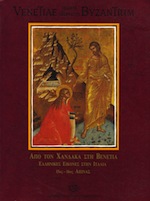 2. From Candia to Venice: Greek Icons in Italy – 15th-16th centuries, Nano Chatzidakis [Da Candia a Venezia: Icone Greche in Italia – XV-XVI secolo]. Athens 1993.
2. From Candia to Venice: Greek Icons in Italy – 15th-16th centuries, Nano Chatzidakis [Da Candia a Venezia: Icone Greche in Italia – XV-XVI secolo]. Athens 1993.
Series: Venetiae Quasi Alterum Byzantium.
Separate Greek, English and Italian editions: xviii+200 p., 28×21, ISBN 960-85461-2-5.
€ 38,00
This book, the catalogue of the exhibition of the same name, deals with icons originally from Candia and now in churches and museums in the general area of Venice. Candia was a production centre of icons known as Italo-Cretan because of the mutual influence between the Byzantine and Italian styles evident in them. A total of forty-eight icons are presented from ten different towns, mainly in North Italy. Many of them are Cretan icons kept in museums in Italian towns, and their presence here is frequently linked with the development of Greek communities, as in Venice, Trieste and Leghorn, though the precise provenance of the items in most of the collections is not known.
Most of the icons in this publication have never previously been studied at all, or at best to a limited degree. They belong mainly to the artistic currents of the 15th and 16th century, and emphasis is placed on the importance of 15th-century Cretan painting, especially by painters such as Andreas and Nikolaos Ritzos, Andreas Pavias, Nikolaos Tzafouris, Georgios Klontzas, and also on the painting of Ioannes Permeniates, Emmanuel Lombardos and Victor in the following centuries.
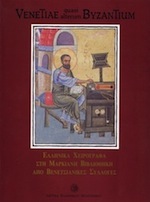 3. Venetian Collections of Greek Codexes, from the Holdings of the National Library of St. Mark’s, Marino Zorzi, ed. [Collezioni Veneziane di Codici Greci, dalle Raccolte della Biblioteca Nazionale Marciana]. Venice 1993. Athens 1994.
3. Venetian Collections of Greek Codexes, from the Holdings of the National Library of St. Mark’s, Marino Zorzi, ed. [Collezioni Veneziane di Codici Greci, dalle Raccolte della Biblioteca Nazionale Marciana]. Venice 1993. Athens 1994.
Series: Venetiae Quasi Alterum Byzantium.
Separate Greek and Italian editions: 124 p., 28×21, ISBN 960-85461-5-Χ.
€ 30,00
The present publication, the catalogue of the exhibition of the same name, is a collective work devoted to the Greek manuscripts collected by Cardinal Bessarion, Francesco Barbaro, the Grimani brothers, Giacomo Contarini, and many other Italian collectors (9th to 17th century). It includes an introduction and extensive accounts of the exhibits (classified according to their provenance), tables of manuscripts and collectors, a bibliography and an index. The texts were written by the director of the Marcian Library, Marino Zorzi, and his colleagues and were translated into Greek by Agamemnon Tselikas. The catalogue begins with a 15th-century codex for which there was an act of donation by Bessarion to the Venetian Republic – essentially the act of registration creating the Library of Saint Mark. It continues with a reference to the Byzantine treasury in the Basilica of Saint Mark and the codices that come from it, followed by the ecclesiastical libraries of the Monastery of Zanipolo, and St Michael of Murano, and concluding with the exhibits from the collections of the patricians and citizens Lorenzo de Monakis, Francesco Barbaro, Leonardo Giustinan, the Grimani brothers, Giacomo Contarini and many others, who collected Gospel Books, ancient historical, philosophical, ecclesiastical, legal, geographical, poetic, astrological, rhetorical and medical texts, and lexicons.
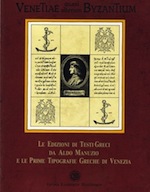 4. Editions of Greek Texts by Aldus Manuzios and the Early Greek Printers of Venice, Μ. Ι. Manoussacas & Κ. Staikos, eds. [Le Edizioni di Testi Greci da Aldo Manuzio e le Prime Tipografie Greche di Venezia]. Athens 1993.
4. Editions of Greek Texts by Aldus Manuzios and the Early Greek Printers of Venice, Μ. Ι. Manoussacas & Κ. Staikos, eds. [Le Edizioni di Testi Greci da Aldo Manuzio e le Prime Tipografie Greche di Venezia]. Athens 1993.
Series: Venetiae Quasi Alterum Byzantium.
Italian-Greek edition: 160 p., 28×21, ISBN 960-85461-4-1.
€ 32,00
This book, the catalogue of the exhibition of the same name, which was held in the Greek Institute in Venice, presents 43 incunabula (about 1486 to 1500) and early printed books (1500-1516) by Greek authors, which were printed in Venice. It includes publications by the most famous Renaissance printer and publisher, Aldus Manutius (1450-1515) and his Greek colleagues, experienced philologists, proof readers and craftsmen, such as Markos Mousouros; and also books printed by other Greek publishers, such as Zacharias Kalliergis, Nikolaos Vlastos and Laonikos Kavvadatos. These publications acquainted people with ancient Greek authors, from Homer to Gregory Nazianzenos and from Plato to Plutarch, and made Venice the intellectual capital of Europe.
A brief biographical note and list of works is attached for each author or publisher. There is also a bibliography and an index of proper names. Each of the 43 Catalogue entries is prefaced with a record of the bibliography of the document, including references to the basic bibliographical lists, and with an explanatory note on the book itself and the bibliographical and technical problems.
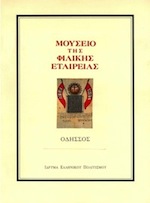 5. Catalogue of the Museum of the Philike Etairia in Odessa [Μουσείο της Φιλικής Εταιρίας: Οδησσός – Κατάλογος]. Athens 1994.
5. Catalogue of the Museum of the Philike Etairia in Odessa [Μουσείο της Φιλικής Εταιρίας: Οδησσός – Κατάλογος]. Athens 1994.
Separate Greek and Ukrainian editions: 144 p., 26×19, ISBN
960-85461-6-8 (Greek), ISBN 960-85461-8-4 (Ukrainian).
€ 20,00
The Catalogue of the Museum of the Philiki Etairia [Friendly Society] is not merely a record of the exhibits on display in the museum, but comprehensively sets the historical context, with authoritative texts written by scholars of repute: Grigori L. Ars, historian at the Institute of Slavonic and Balkan Studies of the Russian Academy of Sciences deals with “The Greeks in Russia”; the historian Aikaterini Koumarianou with “The Greeks of Odessa, from the Community of merchants to the Philiki Etairia”; and I. K. Mazarakis-Ainian with “The Philiki Etairia”. The researcher-historian Despoina Vlami selected and annotated the exhibits, which consist of both originals and copies – that is to say typographical reprints – of items now in the Historical and Laographic Museum of Odessa, the Gennadius Library, the Portrait Archive of the Centre of Neohellenic Research of the National Hellenic Research Foundation, the National Library of Greece, the Archive and National Historical Museum of the Historical and Ethnological Society of Greece, the Benaki Museum, and in private collections: they include busts of members of the Society, portraits and other art items, maps, flags, encoded identity documents, seals, letters, proclamations and other documents.
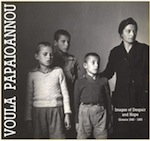 6. Images of Despair and Hope: Greece 1940-1960, Voula Papaioannou [Bilder der Verzweiflung und Hoffnung: Griechenland 1940-1960]: From the Photo Archive of the Benaki Museum, Foundation for Hellenic Culture – Benaki Museum. Athens 1994.
6. Images of Despair and Hope: Greece 1940-1960, Voula Papaioannou [Bilder der Verzweiflung und Hoffnung: Griechenland 1940-1960]: From the Photo Archive of the Benaki Museum, Foundation for Hellenic Culture – Benaki Museum. Athens 1994.
Separate English and German editions: 54 p., 52 ill., 22×24, ISBN 960-85160-3-Χ. Please note that only the English edition remains available.
€ 15,00
“Images of despair and hope” from the German Occupation and post-war Greece, as seen through the lens and heart of Voula Papaioannou. “Voula Papaioannou realised that her lens could record events at first hand and with consistency. So, while her male colleagues were sent as correspondents to the front to record the struggle on the field of battle, it was the tragic moments of those who stayed behind that her camera immortalised in time. Far from the superficial and speedy coverage of events, far from the hunt for officialdom and the centres where great decisions are made, she approached the anonymous who bear the burden of history. She witnessed and shared in the farewells of the recruits, in the preparations of the city to face the urgent situation, and in the care of the first wounded. With extraordinary sensitivity and profound emotion she captured a look of patient endurance, a close embrace, a gesture of humaneness; indeed she records on the photographic paper the ethos of an entire generation. Her photographs are not dithyrambic; they express suffering, dignity, belief in human strength”. (From the text by Fani Constantinou.)
This book, the catalogue of the exhibition of the same name contains fifty-two photographs and a text by Thanassis Valtinos, and was edited by Irene Bourdouris. The two texts were translated into English by Miriam Caskey and Kay Cicellis, and into German by Athanassios Tsingas and Andrea Schellinger.
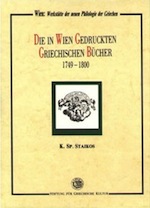 7. Greek Books Printed in Vienna, K. Sp. Staikos [Die in Wien Gedruckten Griechischen Bücher: 1749-1800]. Athens 1995.
7. Greek Books Printed in Vienna, K. Sp. Staikos [Die in Wien Gedruckten Griechischen Bücher: 1749-1800]. Athens 1995.
Series: Vienna: Workshop of the New Greek philology.
German-Greek edition: xxxix+432 p., 28×21, ISBN 960-7622-00-6.
€ 42,00
This book is the catalogue of the exhibition of the same name organised by the Hellenic Foundation of Culture in 1993 in the National Library of Austria. It is devoted to the Greek presses of Vienna from 1749 to 1800, and to the determined efforts of subjugated Hellenism to preserve its cultural heritage, language and Orthodox faith. In it are presented 151 books from the National Libraries of Austria and Greece, the Library of the Greek Parliament, the Gennadius library, the Koventareios Municipal library of Kozani, the “Spyros Loverdos Library” Foundation, the Laography Centre of the Aristotle University of Thessaloniki, and private collections. Extensive references to all the exhibits are contained in the 460 pages of the catalogue. It includes a bibliographical record of all the Greek documents printed in Vienna during the period in question and also an extensive bibliography, as well as a Greek and Latin index.
From the height of the Greek Enlightenment down to the eve of the Greek national liberation struggle, the Greek community of Vienna engaged in intensive publishing activity that made the city a “workshop of the new Greek philology” (Korais). Three main factors led to the flowering of Greek printing from the middle of the 18th century in this city. First, the presence there of two organised, commercially active Greek communities, centred on the churches of Ayia Triada and Ayios Georgios, in combination with the wider influence of the Austrian Empire in the Balkans. Second, the context of the Greek Enlightenment and the conviction that progress towards the liberation of the Greeks presupposed a more general intellectual and educational reform. And third, the orientation of the great book-producing centres of the Austrian capital mainly towards the Greek language. In 1785, Vienna had five printer’s establishments and dozens of presses, which produced handbooks of grammar, lexicons and encyclopaedias, translations of important novels of the day, Western plays, popular treatises on the latest scientific discoveries, and many other monumental works that gave expression to Greek concerns and visions of liberation.
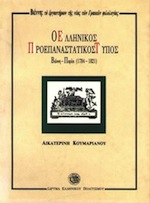 8. The Greek Pre-Revolutionary Press: Vienna – Paris (1784-1821), Aikaterini Koumarianou [Die Griechische Vorrevolutionäre Presse: Wien – Paris (1784-1821)]. Athens 1995.
8. The Greek Pre-Revolutionary Press: Vienna – Paris (1784-1821), Aikaterini Koumarianou [Die Griechische Vorrevolutionäre Presse: Wien – Paris (1784-1821)]. Athens 1995.
Series: Vienna: Workshop of the New Greek philology.
German-Greek edition: 228 p., 28×21, ISBN 960-7622-01-4.
€ 25,00
This book is the catalogue of the exhibition of the same name held in the National Library of Austria. It is a systematic record by Aikaterini Koumarianou of the historical evidence for the Greek Press in Vienna and later in Paris during the period 1784-1821 (that is, before the outbreak of the Greek War of Independence): Ephemeris, Hellenikos Telegraphos, Hermes o Logios, Eideseis dia ta Anatolika Mere, Kalliope, Melissa, Athena, Mouseion, Iris e ta nyn Hellenika. It includes footnotes, a catalogue of exhibits, an index and a list of illustrations.
In the late 18th century, the Greeks began to use a medium of communication that was new to them: newspapers and literary journals. Although lagging behind western societies, which published newspapers already at the beginning of the 17th century, the Greeks at once embraced this activity, recognising its dynamic potential. This resulted in the Greek Press becoming, over time, one of the most important expressions and activities of Greek economic, social, intellectual and cultural life. In the decade leading up to 1821, in particular, the Greek Press acquired a reputation for reliability that enabled it – both on account of the experience it had gained in previous years, and as a result of the widespread climate of liberal democracy in Western Europe – to shape attitudes and consciousnesses, so that it became an element of progress in the life of the Greek people. These news sheets pose the concerns of Greek education and culture and disseminate the latest scientific knowledge in accordance with the dictates of the Enlightenment. They also capture the ideological confrontations about vital current affairs and the tensions that arose from the different attitudes adopted by authoritative circles of Greek society at that period.
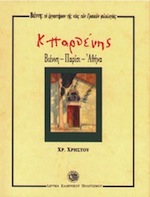 9. Konstantinos Parthenis: Vienna – Paris – Athens, C. Christou. Athens 1995.
9. Konstantinos Parthenis: Vienna – Paris – Athens, C. Christou. Athens 1995.
Series: Vienna: Workshop of the New Greek philology.
Separate Greek, English and German editions: 128 p., 28×21, ISBN 960-7622-02-2.
€ 25,00
This book is the catalogue of the exhibition of the same name held in the Vienna Academy of Fine Arts. It is devoted to Konstantinos Parthenis, one of the most important figures in Greek twentieth-century painting, who led to the acceptance of formal freedom in Greek art. The thirty-one paintings presented, which come from the National Gallery and Alexandros Soutzos Museum, the A. G. Levendis Foundation, the Sp. Loverdos Foundation and private collections, are discussed by Professor Chr. Christou, and he book is edited by Dimitris Pavlopoulos.
“His vocabulary was never that of a realist, and he moves on to an increasing degree of stylization, and the use of mannerist types and problematic space, in which his ideas and symbols find their place. After an early phase in which a definitive role was assigned to colour, he moved on to a use of colour with rather symbolical implications, ending with increasingly diluted, thin paint. In this way he succeeded in intensifying the picture surface and in emphasising the role played by drawing. Step by step, he went through an internal process by which he arrived at a purely summary expressive language, which made it easier for him to hint at his meetings and emotions. All this led to his final works, to an art of symbolical allusions, in which the material is given an immaterial quality and the forms are made spiritual. To paintings in which everything seems to be dissolved in a transcendental light, and in which every element acquires added dimensions. In which the material has been transformed into spirit and the form has become an image of the idea.” (From the Introduction by Chrysanthos Christou.)
The translation is by Dr David A. Hardy.
 10. Dimitri Mitropoulos: His Life and Work, A. Kostios [Dimitri Mitropoulos: Leben und Werk]. Athens 1995.
10. Dimitri Mitropoulos: His Life and Work, A. Kostios [Dimitri Mitropoulos: Leben und Werk]. Athens 1995.
Series: Vienna: Workshop of the New Greek philology.
German-Greek edition: 96 p., 28×21, ISBN 960-7622-05-7.
€ 18,00
This bilingual catalogue of the exhibition of the same name held in Vienna in 1995, offers a rounded approach to the famous Greek musician. It contains biographical details of Dimitri Mitropoulos and special chapters on his career as an interpreter and composer, and on his love for Gustav Mahler; also a catalogue of world premier performances and a list of works from his first and second period as a composer, footnotes and a bibliography.
In Vienna, the artist worked with the Vienna Philharmonic, during which time he experienced some of the few great, happy moments of his life, which he described himself in 1954. Thanks to the Hellenic Foundation for Culture, objects associated with the artist’s personal and professional life were brought to the Konzerthaus in this city of music, as part of a varied series of events. The objective of the exhibition, and also of the publication, was to present a synthetic picture of Mitropoulos the artist and the man.
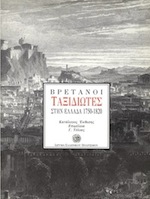 11. British Travellers in Greece: 1750-1820, G. Tolias, ed. Introduction by Aikaterini Koumarianou. Athens 1995.
11. British Travellers in Greece: 1750-1820, G. Tolias, ed. Introduction by Aikaterini Koumarianou. Athens 1995.
Greek-English edition: xxx+114 p., 28×21, ISBN 960-7622-06-5.
€ 20,00
This book is the catalogue of an exhibition held in London of the works of eminent British visitors to Greece in the period from 1750 to 1820, just before the beginning of the Greek War of Independence. The exhibits consist of books, unbound engravings and original paintings, which highlight the diversity, dynamism and broad scope of the three successive generations of British travellers to Greece, each with its own characteristics. The third generation, of the period 1800-1820, is the most glorious and the most revealing. At no other time had so many important, energetic travellers of the same nationality been simultaneously in Greece. At no other time had so much been written in the same European language about Greece, its antiquities, its society and its geography. From Elgin to Byron, from Clarke to Cockerell, from Eton to Guilford, via Dodwell, Cartwright and Williams, this generation swept through Greece and inundated Britain with writings, images and Greek ideas.
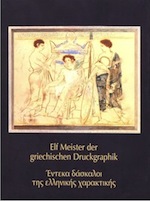 12. Eleven Masters of Greek Printmaking, Marilena Ζ. Cassimatis [Elf Meister der griechischen Druckgrafik]. Hellenic Foundation for Culture – National Gallery–Alexandros Soutzos Museum. Athens 1995.
12. Eleven Masters of Greek Printmaking, Marilena Ζ. Cassimatis [Elf Meister der griechischen Druckgrafik]. Hellenic Foundation for Culture – National Gallery–Alexandros Soutzos Museum. Athens 1995.
Greek-English and Greek-German editions: 80 p., 28×21.
€ 20,00
This book is the catalogue of the exhibition that was presented at all the Branches of the Hellenic Culture Foundation in the two years 1995-1996. In it are presented the works of five Greek print-makers whose careers fall in the period from 1914 to 1976 and who were later declared masters of their art. The artists in question were educated mainly in Italy, France and Germany and went on to transmit their art, with a sound foundation in technical expertise, to successive talented generations of students at the Athens School of Fine Arts. Galanis, Kefallinos, Ventouras, Katraki, Tassos, Kogevinas, Theodoropoulos, Papadimitriou, Yannoukakis, Hadjikyiakos-Ghikas and Moschos – each has written his own story on the way to the achievement of excellence in his field. From 1936 on they participated in the print-making Biennalia held in Venice, Paris, Prague and Leipzig, and the exhibition thus reflected the integration of Modern Greek art into European art.
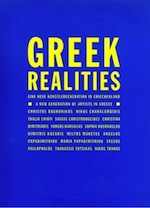 13. Greek Realities: A new Generation of Artists in Greece, Birgit Hoffmeister, Yorgos Tzirtzilakis, eds. [Greek Realities: Eine neue Künstlergeneration in Griechenland], Stiftung Neue Kultur. Athens 1996.
13. Greek Realities: A new Generation of Artists in Greece, Birgit Hoffmeister, Yorgos Tzirtzilakis, eds. [Greek Realities: Eine neue Künstlergeneration in Griechenland], Stiftung Neue Kultur. Athens 1996.
English-German edition: 112 p., 30×24, ISBN 3-931226-01-8.
€ 22,00
Installations, objects, paintings videos and photographs – the investigation of the identity of modern reality as crystallised in the work of fourteen young Greek artists: Christos Bouronikos, Nikos Charalambidis, Thalia Chioti, Savvas Christodoulides, Christina Dimitriadis, Yorgos Harvalias, Sophia Kosmaoglou. Dimitris Kozaris, Miltos Manetas, Angelos Papadimitriou, Maria Papadimitriou, Tassos Pavlopoulos, Thanassis Totsikas and Nikos Tranos.
The book is the catalogue of the exhibition mounted in Berlin (1996-1997), which attempted not only to approach the young artists from an aesthetic point of view, but also to understand their social and political stance towards their country, and their place in the European process.
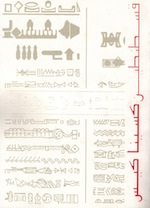 14. Constantin Xenakis: Retrospective 1958–1996: The Return of the Artist introduction by C. Christou [Κωνσταντίνος Ξενάκης, Αναδρομή 1958-1996: Η επιστροφή του καλλιτέχνη ]. Athens 1996.
14. Constantin Xenakis: Retrospective 1958–1996: The Return of the Artist introduction by C. Christou [Κωνσταντίνος Ξενάκης, Αναδρομή 1958-1996: Η επιστροφή του καλλιτέχνη ]. Athens 1996.
Greek-Arabic edition: 152 p., 29×21, ISBN 960-7622-08-1.
€ 22,00
This book is the catalogue of the major retrospective exhibition of works by the Greek painter from Egypt, Contantin Xenakis. It represents the artist’s return – both literal and symbolic – to the country he left at the age of 21, the memories of which are diffused throughout his work. Geometric shapes, ancient and modern scripts, hieroglyphics, signs and codes of communication drawn from the modern world are the characteristic features of his expression. Xenakis is an internationally recognised artist, whose work is marked by perpetual experimentation, a constant questing and a challenging of facts.
Centuries of cultural relations and strong ties of friendship link Greece with Egypt. Art, the supreme expression of humanity, facilitates communication between people and is a motive force behind the renewal and extension of dialogue between two countries with a long relationship and history. “A creative artist with wide-ranging concerns, Xenakis exploits his personal experience, his individual aspirations and new contrivances that lend his artistic output an authenticity, immediacy, quality and expressive truth. Through the clarity of his composition, the fullness of his forms, the nobility of his colour and the character of his space, he successfully gives expression to the main concerns of our world. All that remains is to add that this gifted, authentic artist has not only already given us much, but, like other artists of his generation, continues his questing, expands his expressive means, and constantly enriches his formulations with new values.” (From the introduction to the bilingual exhibition catalogue by Chrysanthos Christou.)
The translation into Arabic is by Dr. Naim Attia.
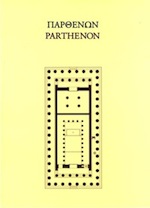 15. The Parthenon: Architecture and Conservation, Μ. Korres, G. A. Panetsos, T. Seki, eds., Hellenic Foundation for Culture – Committee for the Conservation of the Acropolis Monuments. Athens 1996, 1999.
15. The Parthenon: Architecture and Conservation, Μ. Korres, G. A. Panetsos, T. Seki, eds., Hellenic Foundation for Culture – Committee for the Conservation of the Acropolis Monuments. Athens 1996, 1999.
Greek-Japanese-English edition (1996); Greek-English revised edition (1999): 144 p., 34×24, ISBN 960-7424-15-8. Please note that only the original 1996 edition is available.
€ 32,00
The book is the catalogue of the exhibition organised by the Hellenic Foundation for Culture in collaboration with the Committee for the Conservation of the Acropolis Monuments (CCAM). In it was presented a selection from the documentation of the mammoth task of investigation, restoration and conservation that has been carried out on the Acropolis over the last twenty-five years. The exhibition focused on the Parthenon and was accompanied by the unique life-size cast of the West Frieze. It was held in Osaka, Japan, as part of a four-day interdisciplinary conference (1996), and in Bucharest, Belgrade, Skopje, Alexandria, Nicosia, Zagreb, Odessa and Kiev (1999-2002). In addition to this publication, a pamphlet was printed (in English, Romanian, Serbian, Croatian, Arabic, Ukrainian and Greek) and distributed to the public during the exhibitions.
The contributors to the catalogue include Professor Th. Skoulikidis, A. Galanos, G. Doganes, K. Zambas and N. Toganides. The text was translated into English by Dr. David A. Hardy and into Japanese by Professor T. Seki. The book contains drawings made by Manolis Korres and discusses subjects such as the historical background, architecture, sculptures, bilateral symmetry, isomorphism and contrast with nature, the individuality of architectural members, and the alternative state of articulated architecture, historical phases and restorations, the work of restoration, architectural restoration, structural restoration, conservation of stones, conserving the Parthenon and architectural models.
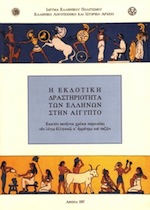 16. Greek Publishing Activity in Egypt: 150 Years of ‘the Greek Language in Verse and in Prose’, introduction by Efthimios Soulogiannis. Hellenic Foundation for Culture – Hellenic Literary and Historical Archive. Athens 1997.
16. Greek Publishing Activity in Egypt: 150 Years of ‘the Greek Language in Verse and in Prose’, introduction by Efthimios Soulogiannis. Hellenic Foundation for Culture – Hellenic Literary and Historical Archive. Athens 1997.
Greek-English-Arabic edition: 112 p., 29×21, ISBN 960-201-125-4.
€ 18,00
This book presents the uninterrupted Greek publishing activity in Egypt over a period of some 140 years, seen through 523 titles of books, periodicals, newspapers and a wide range of printed matter.
The Greeks born in Egypt had an extremely prominent presence in all fields of human activity during the last 150 years. The historical sources for Hellenism in Egypt are of considerable volume and value. It was therefore one of the first concerns of the Hellenic Foundation for Culture, through its Branch in Alexandria, to promote this historical material, especially printed matter from the second half of the 19th and the 20th century. In collaboration with the Greek Literary and Historical Archive, it organised an exhibition in spring 1997 entitled ‘The Greek publishing activity in Egypt. One hundred and fifty years of presence “in the Greek language in verse and prose”’.
The publication that accompanied the exhibition contains a detailed catalogue of the exhibits and 78 illustrations of the material; there are also texts by Manos Charitatos and Professor E. Th. Soulogiannis. The translation into Arabic is by the neohellenist professor of Cairo University, Hamdi Ibrahim. The English translation is by Alexandra Hirozi and Alexandra Charitatou.
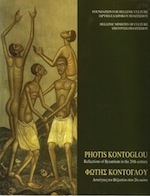 17. Photis Kontoglou: Reflections of Byzantium in the 20th century, introduction by Nikos Zias. Athens 1997.
17. Photis Kontoglou: Reflections of Byzantium in the 20th century, introduction by Nikos Zias. Athens 1997.
Greek-English edition: 80 p., 28×22, ISBN 960-7622-10-3.
€ 18,00
This volume, and the exhibition of the same name mounted in the Branches of the Hellenic Foundation for Culture in New York, London and Berlin was the outcome of collaboration between the Hellenic Foundation for Culture, the Hellenic Ministry of Culture, and the Photis Kontoglou Centre. It presents the great Modern Greek artist and church-painter, who succeeded in creating an authentic Greek art, setting his seal, perhaps more indelibly than any other, on the intellectual identity of the Greek nation in the 20th century.
It contains twenty-one pieces representative of Photis Kontoglou’s creative art from 1923 to 1961. The earlier items reveal the influence of European art, expressionism and popular Greek art, while his dedication to the style of Byzantine art is apparent in the later ones.
The publication was edited by Dr Jenny Albani and Despina Evgenidou of the Directorate of Byzantine and Post-Byzantine Monuments of the Hellenic Ministry of Culture. It includes an introduction by Nikos Zias, Professor of Art History, a chronological table of Kontoglou’s life and works, and a select bibliography. The text was translated into English by John Davis.
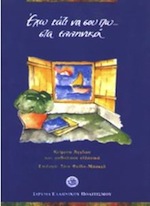 18. I Have Something to Tell You… in Greek, Tina Feidi-Maskell, ed. [Έχω κάτι να σου πω… στα ελληνικά]. Athens 1997.
18. I Have Something to Tell You… in Greek, Tina Feidi-Maskell, ed. [Έχω κάτι να σου πω… στα ελληνικά]. Athens 1997.
Greek edition: 96 p., 22×14, ISBN 960-7622-09-Χ.
€ 15,00
British students of Modern Greek record their thoughts with affection and respect for the language in which they are learning to express themselves. If it is a sign of civilisation for different cultures to be able to coexist, each showing respect, appreciation and gratitude for the distinctive quality of the other, then this little volume of literary short stories written by people who take delight in expressing themselves in Greek, even though they are not Greeks, promotes culture in the broader sense. The book is also a small tribute by the Hellenic Foundation for Culture to all those Greek (and non-Greek) teachers of the Modern Greek language who, through their inventiveness, their dedication and their enthusiasm, ensure that the Greek voice is heard all over the world.
Tina Feidi-Maskell, teacher of Modern Greek in the Continuing Education Department of Exeter University in south-west England, has assembled texts written by her pupils – brief attempts at prose-writing in the language they are learning. This publication is the outcome of the gleaning of this material. The texts are written in simple Greek, yet the literary grace of most of the stories gives the reader a pleasant taste and leaves him with a smile at the end of each little story, all of which are rendered with great immediacy, freshness and humour.
The book is not addressed solely to students of the Modern Greek language. It is also of interest to readers from the general Greek public who my be curious to learn how a few English people, who are taking the trouble to study the Greek language for the joy of communication and because Greek civilisation has great prestige and influence, express themselves in Greek. They are autobiographical episodes referring to Greece or inspired by life in Britain – memories from their childhood and experiences drawn from their life today. Taken together, these texts may form a key to understanding ultimately what it is that makes different people, of different education, mentality and age, choose to learn the Greek language.
The preface was written by Dr Richard McGrady, Director of the Continuing Education Department of Exeter University, who approaches the publication from the point of view of adult education. The texts were edited by Anna Michopoulou.
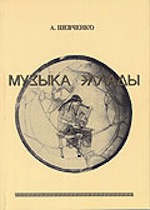 19. The Music of Greece, A. Shevcenko [Музика Еллади]. Odessa 2001.
19. The Music of Greece, A. Shevcenko [Музика Еллади]. Odessa 2001.
Russian edition. Please note that this title is only available from our Branch office in Odessa.
€ 5,00
This publication examines a number of musicological questions relating to an understanding of ancient Greek music. It presents its history and structure, and its influence on the development of the global musical heritage.
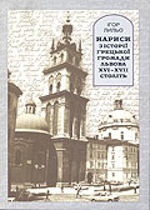 20. Aspects of the History of the Greek Community in Lviv, 16th-17th cent., Igor Lily [Нариси з історії грецької громади Львова XVI – XVII століть]. National Lviv University, Hellenic Foundation for Culture – Odessa. Lviv 2002.
20. Aspects of the History of the Greek Community in Lviv, 16th-17th cent., Igor Lily [Нариси з історії грецької громади Львова XVI – XVII століть]. National Lviv University, Hellenic Foundation for Culture – Odessa. Lviv 2002.
Ukrainian version with English, Polish and Greek summary: 190 pp., 20×15, ISBN 966-553-244-8.
Please note that this title is only available from our Branch office in Odessa.
€ 5,00
Professor Lily publishes the results of his research, which allow the reader to get to know the representatives of the Greek community in Lviv and determine their place in the multiethnic Eastern Europe at the time. The study of the economic, political and cultural heritage of the Greeks examines all aspects of the Greek community’s development.
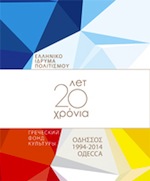 21. Hellenic Foundation for Culture – Odessa: 20 years (1994-2014) [Грецький Фонд Культури в Одесі – 20 років (1994-2014)]. Hellenic Foundation for Culture – Odessa. Odessa 2014.
21. Hellenic Foundation for Culture – Odessa: 20 years (1994-2014) [Грецький Фонд Культури в Одесі – 20 років (1994-2014)]. Hellenic Foundation for Culture – Odessa. Odessa 2014.
Russian-Greek edition: 144 p. 23×31, 978-966-8815-11-9.
€ 10,00
Extensive informative texts cataloguing the events and initiatives of HFC–Odessa: The Philike Etairia Museum, teaching the Greek language, lectures, musical and theatrical events, exhibitions, programs, contests, publishing activity, research activity, library, choir and dance groups. The volume includes contributions by friends of HFC–Odessa.
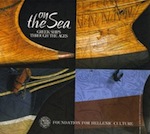 22. On the Sea: Greek Ships through the Ages, Hellenic Foundation for Culture – Hellenic Maritime Museum. Athens 2002.
22. On the Sea: Greek Ships through the Ages, Hellenic Foundation for Culture – Hellenic Maritime Museum. Athens 2002.
English-Greek edition: 144 p., 22×25, ISBN 960-7622-12-X.
€ 30,00
Models of ships from every period of Greek history, paintings, maps and a characteristic pointed amphora that travelled by sea from Greece to New York to be displayed in the Branch of the Hellenic Foundation for Culture there, are presented in this catalogue of the exhibition, with detailed commentaries by members of the Hellenic Maritime Museum. The models of ships in the Museum give prominence to the profound relationship between Greeks and the sea, in an unbroken chain of thousands of years from the dawn of time to the present day.
The catalogue includes articles on every period, written by Constantine Paizis-Paradellis †, Marios Simpsas †, and Anastasios Ι. Tzamtzis: 1) “Prehistoric and ancient times”, 2) “Greek explorers and seafarers in antiquity and the Byzantine period”, 3) “Byzantium and the sea”, 4) “Greek War of Independence (1821-28) and ships of the 19th century”, and 5) “Twentieth century, war and dominance of the Greek merchant marine”.
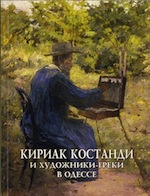 23. Kiriak Kostandi and Greek Painters in Odessa: late XIX – early XX centuries. Odessa 2003.
23. Kiriak Kostandi and Greek Painters in Odessa: late XIX – early XX centuries. Odessa 2003.
English-Russian edition: 204 p., 28×21, ISBN 966-8099-35-4.
€ 35,00
This volume presents a distinguished figure of the Greek community of Odessa, Kiriak Kostandi, a notable painter, teacher and public figure, and the foremost representative of the well-known Southern Russian School of painting, along with some of his pupils and other painters of Greek descent in Odessa from the late 19th to the early 20th century: A. Stilianudi, Ν. Κ. Aleksomati, Μ. P. Latri, Α. Ι. Kuinji, H. D. Kostandi and S. Μ. Vasilopulo.
Each of these painters contributed in his own way, according to his personal talent, to the cultural life of Odessa, hymning and immortalising the natural beauty of the Black Sea coast. Kostandi owed his fame to paintings that sing of the beauty of the landscape of south Odessa and its environs. His work is characterised mainly by a sense of man’s unity with nature. Twilight and sunset were amongst his favourite subjects. P. P. Chistyakof, the renowned professor at the Academy of Arts in St Petersburg, used to say that Odessans have the capacity to converse with nature – and in this Kostandi excelled.
In addition to its visual material, this volumes represents the first publication of historical documents, autograph manuscripts of the painters and other historical records.
 24. Rorris: Painting 1996-2003. Athens 2004.
24. Rorris: Painting 1996-2003. Athens 2004.
Greek-English edition. The catalogue is available in PDF.
“The reds, grays and intermediate gradations and variations of light also in extension of colors, make their mark in the portraits of Rorris. Even his name suggests color and rapidity of image. The painter’s portraits are a deck of cards from which you draw and play, losing as usual, but winning imagination, time and color… These enclosed rooms of the painter with the different persons, want or are trying to approach time but become lost. But the colors find paths, tell their tale, speak with silence. A young woman, perhaps a girl, is sleeping. The floor and walls are a jumble of colors. The window blunted by a brown which blocks all communication with the outside world. The walls conceal commotion and catastrophe. But they remain in place and keep their shape. Antonia sits absent-minded in a red background. From the waist down she fades away. Here the wall is a theatrical set. On a deeper level the painting of George Rorris is about light. Light in all gradations of darkness and surprise, like a light being turned on and off, by a child playing with the switch and our life.” (From the article on the artist by Yannis Kondos entitled “Persons, events and enclosed spaces in the painting of George Rorris”, which is included in this publication.)
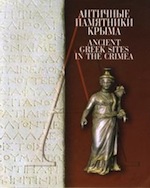 25. Ancient Greek Sites in the Crimea, Tatiana L. Samoylova, ed. Kiev 2004.
25. Ancient Greek Sites in the Crimea, Tatiana L. Samoylova, ed. Kiev 2004.
English-Russian edition with a Greek summary: 288 p., 24×17.
ISBN 966-577-047-0.
€ 32,00
The second archaeological guide published by the Odessa Branch of the Hellenic Foundation for Culture is devoted to the ancient Greek colonies in the general area of the Crimea – Pantikapaion (Kerch), Nymphaion, Tyritaki, Myrmekion, Porthmeion, Kitaion, Theodosia (Feodosia), the Tauric Chersonessos (Sevastopol), Kerkinitis (or Karkini or Kerkini – modern Efpatoria) and Kalos Limen – and is produced in collaboration with the Ukrainian and Russian archaeologists, who were responsible for the excavations.
There are depictions of and commentaries on highly important finds, such as inscriptions, gold and silver objets d’art, masterpieces of toreutics and miniature art, imports from Attica and Ionia, as well as local products, such as vases, clay figurines, miniature artworks and coins, from the 7th century BC. They reveal the prosperity of these city-states, and the constant mutual influences between the colonists and the native population in all spheres of the economy, social life and culture.
 26. Gregorios Maraslis: 175 Years from His Birth [Γρηγόριος Μαρασλής: 175 χρόνια από τη γέννησή του]. Odessa 2006.
26. Gregorios Maraslis: 175 Years from His Birth [Γρηγόριος Μαρασλής: 175 χρόνια από τη γέννησή του]. Odessa 2006.
Russian-Greek edition: 80 p., 29×19, ISBN 966-8815-04-1.
€ 18,00
The Hellenic Foundation for Culture in Odessa, housed in the Maraslis historical residence, honoured the great benefactor of “two homelands” (Greece and Ukraine) by organizing an exhibition dedicated to his life and work. The exhibits come from private collections and public institutions in Odessa, including the State Archive, the Gorky Library, the Historical and Laographic Museum, the Museum of Fine Arts, the Museum of Literature and others.
The lavishly illustrate catalogue of the exhibition contains an extensive introduction on the life and work of the benefactor. The exhibits are divided into the following groups: 1) Maraslis’s youth (1831-185), 2) Benefactions, 3) Personality, and 4) In Memory of G.G. Maraslis.
“For Maraslis, the talented civil servant of the ‘Vorontzov School’, nothing in Odessa was unimportant: theatres and streets, parks and sanatoria, microbiological workshops and libraries, abattoirs and art galleries, churches and schools, cheap restaurants, museums and so much else were of daily concern to him. A highly competent businessman and one of the riches men in the town, he did not concentrate on increasing his personal wealth, but devoted a large part of his life to the prosperity of his beloved Odessa. He was justly called an innovator, since not only did he not fear innovations, but actively sought them and demanded the same from those who worked under him. For all these reasons, the inhabitants of Odessa trusted him implicitly throughout the approximately thirty years that he served as a municipal councillor, as member of the executive committee of the Municipality, and as Mayor.” (From the Prologue by Edward Gourvits, Mayor of Odessa.)
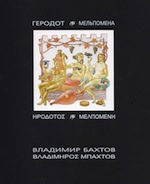 27. Vladimir Bachtov, Herodotus: Melpomene – Engravings [Ηροδότου Ιστορίαι: Μελπομένη – Χαρακτικά]. Odessa 2006.
27. Vladimir Bachtov, Herodotus: Melpomene – Engravings [Ηροδότου Ιστορίαι: Μελπομένη – Χαρακτικά]. Odessa 2006.
Greek-Russian edition: 64 p., 28×24, ISBN 966-8815-02-5.
€ 18,00
Following the steps of Herodotus in the book of his Histories called Melpomene, the Ukrainian artist recounts characteristic incidents from the history of the Scythians and their neighbouring tribes. The figures and subjects are rendered with considerable authority, authenticity and liveliness. He refers to the geography of the region, as well as to historical events that took place on the north coast of the Black Sea. He uses the technique of acid etching, which imitates 18th and 19th century engravings and involves three states of oxidation and tinting the engravings with water colours to achieve greater authenticity and emotional expressivity.
The credibility and authenticity of Vladimir Bachtov’s enterprise stems from the fact that the artist had scientifically studied the archaeological and ethnographic evidence for the Scythians, Greeks and Persians, inter alia with the aid of A. Rusiaeva, V. Mourzina, and E. Chernienko, his colleagues at the Institute of Archaeology of the Ukraine National Academy of Sciences. He had also studied in depth the visual and decorative art of ancient peoples, in an effort to approach the style of Herodotus in his own artistic style. His illustrations, which are deliberately archaic and overtly decorative, recall the stylistic trend of the ancient East, especially Persia, and of later Scythian-Greek models.
 28. Grigori Palatnikov, Homer’s Iliad: Ink Drawings [Ομήρου Ιλιάδα: Σχέδια με μελάνι]. Odessa 2006.
28. Grigori Palatnikov, Homer’s Iliad: Ink Drawings [Ομήρου Ιλιάδα: Σχέδια με μελάνι]. Odessa 2006.
Greek-Russian edition: 60 p., 28×24, ISBN 966-8815-03-3.
€ 18,00
Transference of the epic discourse of the Iliad into narrative painting that goes beyond mere illustration. “The Ukrainian artist listens carefully to Homer and transforms the restless clamour of battle into a feast of graphics, without ever subjecting it to the superficial image of ‘appearance’ . . . Unravelling the thread of their personal values, Homer’s heroes choose, take a stance with regard to events, struggle fiercely, fight madly and conquer, sometimes through guile or boldness, sometimes through courage. The chains of the ineluctable, the irreparable, the predetermined break, symmetry is overturned, as is the archaic order of human relations. The essence of this majestic overthrow is mirrored in a cyclone of dynamic compositions, expressed through asymmetry, through the fracturing of the outline, the countless labyrinthine branches of the lines . . . the figure of the old man, the tragic Priam, bowed yet at the same time upright, next to the chariot that bears the tortured corpse of his beloved son, the bravest of the brave, returns to pose invariably the same, unanswered question: Could it be otherwise?” (From the introduction by Olga Baranovskaya, art critic.)
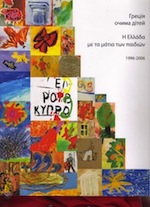 29. Greece Through the Eyes of Children: 1996-2006 [Η Ελλάδα με τα μάτια των παιδιών: 1996-2006]. Odessa 2007.
29. Greece Through the Eyes of Children: 1996-2006 [Η Ελλάδα με τα μάτια των παιδιών: 1996-2006]. Odessa 2007.
Ukrainian-Greek edition: 64 p., 28×33, ISBN 966-8815-05-X.
€ 18,00
This celebratory album is the product of a ten-year project of the Hellenic Foundation for Culture in Odessa: the children’s painting competition “Greece through the eyes of children: 1996-2006”. It includes 60 prize-winning paintings from a total of roughly 6,000 entries, all with themes related to Greece – the Greece of the children’s soul, the Greece that they have never seen.
“When one of the judges, a well-known painter, was asked what criteria were used in choosing the paintings, he replied: ‘The same artistic criteria that I use to evaluate myself’ – an answer as logical as it was unexpected. Spontaneity, that paradoxical force that endows the work of the young artists, speaks to the child. For some time now, children’s painting should have been treated as a separate category of the visual arts… Internal harmony. Good taste. Translucency. Where is the cradle? The beginning? Possibly in the traditions and influence of the Odessa School, known for the delicacy of its aesthetic expression. Or perhaps the pulse of this place recalls a glorious Greek past. The answer nestles in these children’s creations, is the joyous, radiant secret that enable us adults to say, along with the young artists: ‘Yes! The Greece of our souls.’” (From the introduction by Olga Savitskaya, art critic.)
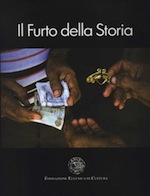 30. History Lost, Neil Brodie, Andreas Apostolidis [Il Furto della Storia; História Perdida], Hellenic Foundation for Culture – Anemon Productions, Athens 2008 (2007).
30. History Lost, Neil Brodie, Andreas Apostolidis [Il Furto della Storia; História Perdida], Hellenic Foundation for Culture – Anemon Productions, Athens 2008 (2007).
Separate English, Italian and Portuguese editions: 72 p., 27×23, ISBN 978-960-7622-15-0.
€ 18,00
The texts by Neil Brodie and Andreas Apostolidis, and the lavish illustrations of this volume reveal the factors that encourage antiquities theft and the well-organised dark paths by which the phenomenon has reached its present, incalculable extent.
Works of art that are removed from the place in which they were found, and which circulate without any documentation linking them to the place and time of their creation, or – worse still – circulate with misleading evidence in order to conceal their illegal origins, cease to be historically documented and are reduced to the level of mere artifacts: that is, they lose their historical value, their most important content, which may be used to reconstitute history and lay the foundations for man’s self-knowledge.
“The looting of archaeological sites is still widespread, and in some countries so severe as to undermine any hope of establishing a proper history of these lands. Let us remember that the most important loss occasioned by looting, is the loss of information. With the destruction of such sites the context of the finds is lost, even if the finds survive…” (Professor Lord Renfrew). This phrase sums up the subject of the volume History Lost, the catalogue of the multimedia exhibition of the same name devoted to the illicit trade in antiquities all over the world, down to the present day. The exhibition was presented by the Hellenic Foundation for Culture in Trieste, and was produced by the ANEMON company in collaboration with the Illicit Antiquities Research Centre – University of Cambridge, the Department of Antiquities of Cyprus, the XXXVII Ephorate of Prehistoric and Classical Antiquities, Corinth, and the Department of Cultural Technology and Communication of the University of the Aegean.
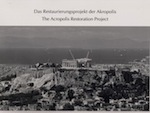 31. The Acropolis Restoration Project: Photographs by Sokratis Mavrommatis [Das Restaurierungsprojekt der Akropolis: Aufnahmen von Sokratis Mavrommatis], Hellenic Ministry of Culture – The Acropolis Restoration Service – Hellenic Foundation for Culture, Athens 2008.
31. The Acropolis Restoration Project: Photographs by Sokratis Mavrommatis [Das Restaurierungsprojekt der Akropolis: Aufnahmen von Sokratis Mavrommatis], Hellenic Ministry of Culture – The Acropolis Restoration Service – Hellenic Foundation for Culture, Athens 2008.
German-English edition: 72 p., 24×31, ISBN 978-960-7622-17-4.
€ 20,00
The black and white photographs by Sokratis Mavrommatis, the photographer of the Committee for the Conservation of the Acropolis Monuments, acquire an importance that might well be termed historical: they document in a unique way the course of the great archaeological works of restoration of the Athenian Acropolis covering the period from 1975 on, and comprise:
a) The causes for which intervention was necessary. Illustrated here are some of the damage and wear inflicted on the monuments by both nature and man during the 25 centuries of their history.
b) The preparation for intervention, in which is shown concisely the work-site preparation necessary for accomplishing the tasks.
c) The main works that are carried out in a unique way by specialized personnel.
d) The monuments themselves shown during the various phases of the restoration project. These photographs show as well the incomparable beauty of the architecture of the classical 5th century buildings.
Mavrommatis had everything needed for this immense project that ran parallel to the restoration: dedication, experience, documentary skill, extraordinary sensitivity of what is right in each photographic situation and great natural artistic talent.
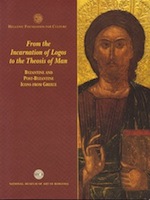 32. From the Incarnation of Logos to the Theosis of Man: Byzantine and Post-Byzantine Icons from Greece. Hellenic Foundation for Culture – National Museum of Art of Romania [Από τη σάρκωση του Λόγου στη Θέωση του Ανθρώπου: Βυζαντινές και μεταβυζαντινές εικόνες από την Ελλάδα, Ελληνικό Ίδρυμα Πολιτισμού–Εθνικό Μουσείο Τέχνης της Ρουμανίας]. Athens 2008.
32. From the Incarnation of Logos to the Theosis of Man: Byzantine and Post-Byzantine Icons from Greece. Hellenic Foundation for Culture – National Museum of Art of Romania [Από τη σάρκωση του Λόγου στη Θέωση του Ανθρώπου: Βυζαντινές και μεταβυζαντινές εικόνες από την Ελλάδα, Ελληνικό Ίδρυμα Πολιτισμού–Εθνικό Μουσείο Τέχνης της Ρουμανίας]. Athens 2008.
Separate Greek, English and Rumanian editions: 166 p., 28×21, ISBN 978-960-7622-20-4.
€ 38,00
Exhibition catalogue presenting sixty-four valuable icons, spanning the period from the waning of the Byzantine Empire in the 14th c. to the appropriation of western stylistic elements, mostly of Venetian origin, in the 18th c., which, however, did not affect the doctrinal principles of the art.
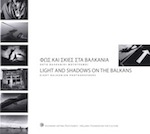 33. Light and Shadows on the Balkans: Eight Balkan Photographers. Athens 2009.
33. Light and Shadows on the Balkans: Eight Balkan Photographers. Athens 2009.
Greek-English edition: 156 p., 27×30, ISBN 978-960-7622-24-2.
€ 35,00
Catalogue of a group photography exhibition of the same name, organized by the Hellenic Foundation for Culture, with eighty black-and-white photographs by young artists from the Balkans – Croatia, Greece, Albania, Bosnia-Herzegovina, Romania, Bulgaria, Turkey, Serbia.
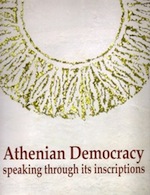 34. Athenian Democracy Speaking Through Its Inscriptions. Catalogue for the exhibition of inscriptions from the Epigraphic Museum. The Hellenic Ministry of Culture/Epigraphic Museum – Hellenic Foundation for Culture – University of Athens. Athens 2009.
34. Athenian Democracy Speaking Through Its Inscriptions. Catalogue for the exhibition of inscriptions from the Epigraphic Museum. The Hellenic Ministry of Culture/Epigraphic Museum – Hellenic Foundation for Culture – University of Athens. Athens 2009.
English edition: 156 p., 31×24, ISBN 978-960-89862-2-0.
€ 28,00
The concepts of democracy and publicity are profoundly and organically interlinked. Τhe constitution and functioning of the first democracy in the world, the Athenian democracy, through documents recorded on the durable material of stone, are presented in this exhibition catalogue with inscriptions, clay public tokens, a clepsydra – water clock, juror’s ballots, a juror’s tablet, and ostracism sherds (free translation of the texts, and commentaries).
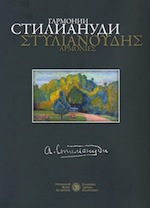 35. Alexandros Stylianoudis: Harmonies [Αλέξανδρος Στυλιανούδης: Αρμονίες]. Odessa, 2010.
35. Alexandros Stylianoudis: Harmonies [Αλέξανδρος Στυλιανούδης: Αρμονίες]. Odessa, 2010.
Russian-Greek edition: 68 p., 28×23, ISBN 978-966-8815-09-6.
€ 20,00
Catalogue of the exhibition, under the same title, organized by the HFC in Odessa, in cooperation with the city’s Museum of Fine Arts and private collectors. Stylianoudis (1868-1948) was one of the most important Greek painters of Odessa who contributed to the formation of the South Russian School of painting. A student of K. Konstantis, has assimilated many techniques of drawing and painting. He became an expert of landscape painting and was known for his small dimension paintings.

You must be logged in to post a comment.